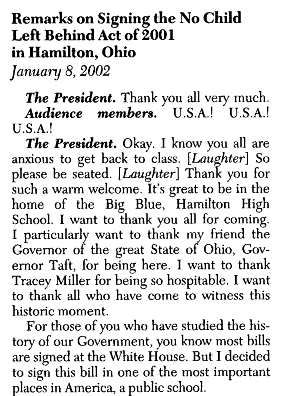
When signing or vetoing a bill, the President may issue a statement about the law. These presidential signing statements are published in compilations of presidential documents. (Until 2016, they were also later included in the president's public papers.) The daily compilation has been online only since 2009. Compilations were previously published in print for each day and week of a presidential administration (as the Daily Compilation and Weekly Compilation of Presidential Documents respectively).
Please note, access to certain databases linked in this guide may be restricted to UT Law or the UT community; please see the library's Databases page that lays out access privileges.
Example from the No Child Left Behind Act.
Bluebook citation, Rule 14.7(b): President's Remarks on Signing the No Child Left Behind Act of 2001 in Hamilton, Ohio, 1 Pub. Papers 23 (Jan. 8, 2002).

View full-text at HeinOnline.
U.S. Code Congressional and Administrative News (USCCAN) is a unique resource published by West, available on Westlaw. It offers two sets of volumes per Congress: one set is a reprint of the Statutes at Large and the other set is labeled "Legislative History," containing lists of citations, abridged reports, and presidential signing statements.
Thus USCCAN has characteristics of both a compilation and a list of citations. However, because it reprints only highlights from a law's legislative history, it is not a comprehensive source as either a compilation or a list. Still, it can be quite convenient to use--you will find references to the relevant portions of USCCAN listed by section in the USCA. Because it focuses on the highlights, it can be a good first source to check.
